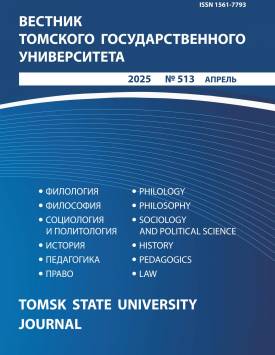The poetics of the table of contents and the value architectonics of Aleksey Varlamov's novel The Mental Wolf
The article analyses the poetics of the titles of Aleksey Varlamov's novel. The Mental Wolf (2014) is exained in order to reconstruct the author's worldview and the value bases behind it. It is substantiated that the structure of the table of contents of Varlamov's novel expresses the spatial organisation of the work in terms of the opposition between East and West in light of Christian symbolism. Varlamov expresses the spatial organisation of the work from the point of view of the opposition between East and West in the light of Christian symbolism, includes two binary oppositions that characterise the novel's value architectonics and forms the contours of the author's worldview as a reception of the transitional historical epoch in Russia. Within the framework of this projection, the image of Pavel Matveyevich Legkobytov is read through the prism of Bulgakov's character Levi Matvey in the context of a ritual event unfolding in the forest of Shelom (an anagram of the city of Yershalayim). The titles of the first and fourth chapters in this model characterise the vertical axis, in which the poles are the "Hunter" Legkobytov and the "Prestidigitator" Krud. Both writers are endowed in the novel with a prophetic gift, actively participate in the fate of Ulyana Komissarova (as a symbol of Russia) and act as the only creative force capable of resisting the devilish plans of the mental wolf. But while Legkobytov stands firmly on the ground, realises nature as his beloved and bride, entering into a spiritual and mystical relationship with it, Krud with all his being rushes to the heavenly heights, seeing with the help of the writer's gift of the hidden and mysterious world as a horizon of spiritual transformation of reality according to aesthetic laws. Another variant of Russia's future is projected in his conversation with Komissarov by another prestidigitator - the Bolshevik revolutionary Uncle Tom. This Mephistophelean-type character combines the potential of state power and devilish strength. He believes in Russia's life-saving mission, but in order to do so, he believes, the Russian land must be remade and another nation must be created that can win a new world war. The second and third chapters are located in the central part of the novel's table of contents system and correspond to the left and right sides of the Orthodox cross in the sign system of the crucifixion. This spatial orientation, on the one hand, is conditioned by solar symbolism and the projection of the ritual event in the title of the chapter "Give the Rain" to the crucifixion of Yeshua in Yershalayim, depicted in Bulgakov's novel The Master and Margarita. On the other hand, it is determined by the lunar symbolism in the chapter "Sventzian Breakthrough" and the location of the meeting of Legkobytov and the mental wolf at the front in the western part of the Russian Empire. The East as a stronghold of Christianity in the artistic world of Varlamov's novel is contrasted with the West, where the mental wolf comes from, bringing with it the destructive power of war and revolutionary (anti-Christian in its basis) ideas of human and world transformation. It is concluded that in the novel's value architectonics the confrontation with the mental wolf is modelled in the aspect of the archetypal Christian plot of death and resurrection, which implies the agony of the cross and atonement for sins. The results of the study point to the modernist genesis of the writer's programmatic work, in which the realistic framework is traced behind the deep mythopoetic layer that determines the motivation of actions and deeds of the main characters. The authors declare no conflicts of interests.
Keywords
A.N. Varlamov, mental wolf, poetics of titles, mythopoetics, semiotics of crucifixion, author's worldview, value architectonics, modernismAuthors
| Name | Organization | |
| Chizhov Nikolay S. | University of Tyumen | n.s.chizhov@utmn.ru |
| Gavrilova Varvara V. | University of Tyumen | gavrilova861@mail.ru |
References

The poetics of the table of contents and the value architectonics of Aleksey Varlamov's novel The Mental Wolf | Vestnik Tomskogo gosudarstvennogo universiteta – Tomsk State University Journal. 2025. № 513. DOI: 10.17223/15617793/513/6
